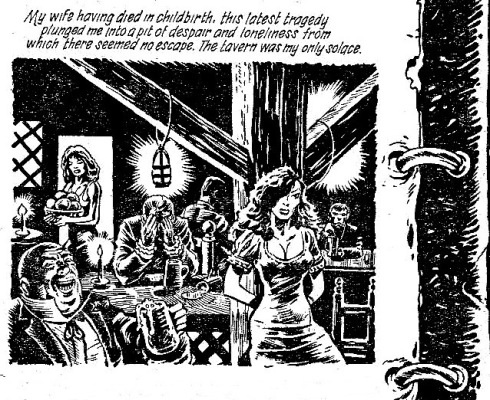PROG: 166 – YE FIRST ROBOT
Script: Gary Rice
Art: Brendan McCarthy
Letters: Tom Frame
Plot: In 1820 an unnamed man mourns the loss of his only child. Whilst brooding over how fate has robbed him of his wife, in labour, and their only child, he decides to create a replacement son from steel and steam. Eventually he emerges from his workshop with a large lumbering humanoid device he calls ‘Robert’, named after his son. Taking the machine to his friend Herr Wilhem he is pleased with its’ reception, even though the elderly gentleman mispronounces its name as ‘Robot’. However, on his return home he finds the local peasants take the machine’s coal fire engine and smokey emissions as a sign that it is the devil’s work. They begin to rally against the defenseless ‘Robert’…
Ending: The locals destroy ‘Robert’, leaving the inventor, once more, all alone. However the whole event has been overseen by two observers, one a dignified aristocrat, the other his man-servant. They ponder re-creating the ‘Robert’ experiment but with flesh and blood instead of steel and steam. As they leave the aristocrat is assured of success by the servant, after all he is Baron Frankenstein!
Thoughts: A very curious Robo-Tale, surrealistically introduced by Ro-Jaws in a Judge’s wig, is written in a most unusual style as a ‘lost journal’ with extensive textual exposition of the images contained beneath each passage. It looks very similar to the ‘illustrated prose’ technique that would be used by Ian Edginton’s Twas The Fight Before Christmas (Prog 2009), or even the word/picture juxtaposition in Alan Moore’s The English / Philondrutian Phrasebook (Prog 214), also illustrated by McCarthy. However by the middle of the second page the separation of text and image has broken down and word-balloons creep increasingly into the story. Adding to the unusual visual effect is the fact that none of the images have a panel boarder and the sides of the pages are made to look like the inside of a ring-binder journal. Why a ring-binder is being used for something seemingly written in 1820 is unclear. By Prog 166 McCarthy had contributed to several substantial stories in the Prog (ABC Warriors, Judge Dredd) but his art here isn’t terribly impressive, certainly a long way from the style that would firmly establish him as a reader favourite. The story itself suffers from having Ro-Jaws act as interlocutor as this limits the narrative’s ability to link the un-named protagonist and the observing Baron Frankenstein. Had not Ro-Jaws told the story it would have made more sense to have had either the Baron or the robot’s builder relate the tale and then explain their link to each other. Certainly it would have been cleverer to have had Frankenstein be a descendant or associate of ‘Robert’s’ creator than just ‘passing by’ as it would have allowed his voice to link into the tale earlier than simply as observing the final act. As a causal character thrown in on the last three panels his presence does strike as an after-thought in a story that was already clearly riffing on Mary Shelley’s classic yarn. The story also loses points for managing to posit Baron Frankenstein being inspired some two years after his own tale had been published in 1818. Basic research from the writer could have set the story in 1810 without altering any key elements. Future Shocks had already re-grounded the Dracula myth (FS 50) so Frankenstein’s turn was always on the cards, sadly this wasn’t the greatest attempt at having fun with the well-trodden source material.
Thrill Power: Pretty minimal. The strange story-telling device makes for a plodding technique which is constantly interrupting the flow of the tale and neither the prose nor the art is compelling enough to compensate. It deserves credit for attempting to play with the form but with the story so obviously echoing The Modern Prometheus and the tacked-on appearance of the Baron constituting the twist it is all quite uninteresting and dull. Easily the best thing about the tale is the unexplained appearance of Ro-Jaws in a Judge’s wig.


